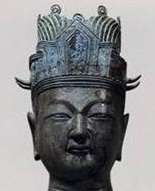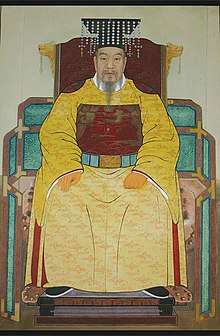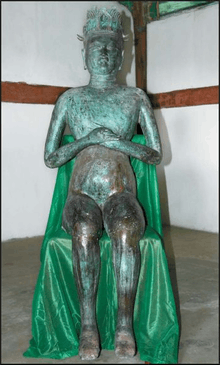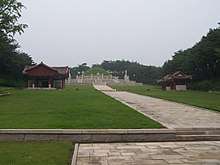Taejo of Goryeo
Taejo of Goryeo (31 January 877 – 4 July 943), also known as Taejo Wang Geon (Wang Kǒn, 왕건), was the founder of the Goryeo dynasty, which ruled Korea from the 10th to the 14th century. Taejo ruled from 918 to 943, achieving unification of the Later Three Kingdoms in 936.[1]
| Taejo of Goryeo 고려 태조 高麗 太祖 Wang Geon (왕건) | |||||
|---|---|---|---|---|---|
 | |||||
| King of Goryeo | |||||
| Reign | 25 July 918 – 4 July 943 | ||||
| Coronation | 25 July 918 | ||||
| Predecessor | Dynasty established | ||||
| Successor | Hyejong of Goryeo | ||||
| Born | 31 January 877 Songak, Unified Silla | ||||
| Died | 4 July 943 (aged 66) Gaegyeong, Kingdom of Goryeo | ||||
| Burial | |||||
| Spouse | Queen Shinhye Queen Janghwa Queen Shinmyeongsunseong Queen Shinjeong Queen Shinseong Queen Jeongdeok | ||||
| Issue | Hyejong of Goryeo Jeonjong of Goryeo Gwangjong of Goryeo | ||||
| |||||
| House | House of Wang | ||||
| Father | Sejo of Goryeo | ||||
| Mother | Queen Wisuk | ||||
| Korean name | |
| Hangul | |
|---|---|
| Hanja | |
| Revised Romanization | Taejo |
| McCune–Reischauer | T'aejo |
| Birth name | |
| Hangul | |
| Hanja | |
| Revised Romanization | Wang Geon |
| McCune–Reischauer | Wang Kǒn |
| Posthumous name | |
| Hangul | |
| Hanja | |
| Revised Romanization | Sinseong-Daewang |
| McCune–Reischauer | Sinsŏng Taewang |
Background
Wang Geon was born in 877 to a powerful maritime merchant family based in Songak (modern Kaesong) as the eldest son of Wang Ryung (Korean: 왕륭; Hanja: 王隆). He traced his ancestry to a noble Goguryeo clan.[2] His ancestors were Goguryeo refugees who settled around Songak, accumulating great wealth through maritime trade and gaining control of the region, including the Ryesong River.[3] During the Later Silla period, the northern regions, including Songak, were the strongholds of Goguryeo refugees,[4][5] and Wang Geon's hometown of Songak would become the original capital of Later Goguryeo in 901.[6]
Rise to power
Taejo began his career in the turbulent Later Three Kingdoms (hanja: 後三國時代). In the later years of Silla, many local leaders and bandits rebelled against the rule of Queen Jinseong, who did not have strong enough leadership or policies to improve the condition of the people. Among those rebels, Gung Ye (궁예; 弓裔) of the northwestern region and Gyeon Hwon (견훤; 甄萱) of the southwest gained more power. They defeated and absorbed many of the other rebel groups as their troops marched against local Silla officials and bandits. In 895, Gung Ye led his forces into the far northwestern part of Silla, where Songdo was located. Taejo's father, Wang Yung (later Sejo of Goryeo), along with many local clans, quickly surrendered to Gung Ye. Wang Geon followed his father into service under Gung Ye, the future leader of Taebong, and he began his service under Gungye's command.
Wang Geon's ability as a military commander was soon recognized by Gung Ye, who promoted him to general and even regarded him as his brother. In 900, he led a successful campaign against local clans and the army of Later Baekje in the Chungju area, gaining more fame and recognition from the king. In 903, he led a famous naval campaign against the southwestern coastline of Hubaekje (Keumsung, later Naju), while Gyeon Hwon was at war against Silla. He led several more military campaigns, and also helped conquered people who lived in poverty under Silla rule. The public favored him due to his leadership and generosity.
In 913, he was appointed as prime minister of the newly renamed Taebong. Its king, Gung Ye, whose leadership helped found the kingdom but who began to refer to himself as the Buddha, began to persecute people who expressed their opposition against his religious arguments. He executed many monks, then later even his own wife and two sons, and the public began to turn away from him. His costly rituals and harsh rule caused even more opposition.
Rise to the throne and founding of Goryeo
| Monarchs of Korea Goryeo |
|---|
|
In 918, four top-ranked generals of Taebong—Hong Yu (홍유; 洪儒), Bae Hyeongyeong (배현경; 裵玄慶), Shin Sung-gyeom (신숭겸; 申崇謙) and Bok Jigyeom (복지겸; 卜智謙)—met secretly and agreed to overthrow Gung Ye's rule and crown Wang Geon as their new king. Wang Geon first opposed the idea but later agreed to their plan. The same year Gung Ye was overthrown and killed near the capital, Cheorwon. The generals installed Wang Geon as the new king of this short-lived state. He renamed the kingdom Goryeo, thus beginning the Goryeo Dynasty. The next year he moved the capital back to his hometown, Gaegyeong.
He promoted Buddhism as Goryeo's national religion, and laid claim to the northern parts of the Korean Peninsula and Manchuria, which he considered his rightful legacy as the successor of Goguryeo.[7] According to the Goryeosa, in 918, the ancient capital of Pyongyang had been in ruins for a long time and foreign barbarians were using the surrounding lands as hunting grounds and occasionally raiding the borders of Goryeo; therefore, in his first year as king, Wang Geon ordered his subjects to repopulate the ancient capital,[8] and soon sent his cousin Wang Sik-ryeom to defend it. Afterward, he decreed Pyongyang as the Western Capital.[9] He also sought alliances and cooperation with local clans rather than trying to conquer and bring them under his direct control.
The War of the Later Three Kingdoms
In 927, Gyeon Hwon of Hubaekje led forces into Silla's capital, Gyeongju, capturing and executing its king, King Gyeongae. Then he established King Gyeongsun as his puppet monarch before he turned his army toward Goryeo. Hearing of the news, Taejo planned a strike with 5000 cavalrymen to attack Gyeon's troops on the way back home at Gongsan near Daegu.[10] He met Hubaekje forces and suffered disastrous defeat, losing most of his army including his generals Kim Nak and Shin Sung-gyeom, the very same man who crowned Wang as a king. However, Goryeo quickly recovered from defeat and successfully defended Hubaekje's attack on its front.
In 935, the last king of Silla, King Gyeongsun, felt there was no way to revive his kingdom and surrendered his entire land to Taejo. Taejo gladly accepted his surrender and gave him the title of prince, and accepted his daughter as one of his wives (Wang had six queens, and many more wives as he married daughters of every single local leader). It caused much disgust to Gyeon Hwon. Gyeon's father, who held his own claim to the Sangju region, also defected and surrendered to Goryeo and was received as the father of a king.
In the same year, Gyeon Hwon's oldest son, Gyeon Singeom (hanja: 甄神劍), led a coup with his brothers Yanggeom and Yonggeom, against their father, who favored their half-brother, Geumgang, as his successor to the throne. Gyeon Hwon was sent into exile and imprisoned in Geumsansa, but escaped to Goryeo and was treated like Taejo's father, who died just before his surrender.
Goryeo victory and unification
In 936, Wang led his final campaign against Singeom of Later Baekje. Singeom fought against Taejo, but facing much disadvantage and inner conflict, he surrendered to Taejo. Wang finally occupied Hubaekje formally, and unified the nation for the second time since Unified Silla; he ruled until 943, and died from disease.
Taejo sought to bring even his enemies into his ruling coalition. He gave titles and land to rulers and nobles from the various countries he had defeated: Later Baekje, Silla, and also Balhae, which disintegrated around the same time. Thus he sought to secure stability and unity for his kingdom which had been lacking in the later years of Silla.
After the destruction of Balhae by the Khitans in 926, Balhae's last crown prince and much of its ruling class sought refuge in Goryeo, where they were warmly welcomed and included into the ruling family by Wang Geon, thus uniting the two successor nations of Goguryeo.[11] Taejo felt a strong familial kinship with Balhae, calling it his "Relative Country" and "Married Country",[12][13] and protected Balhae refugees, many of whom were also of Goguryeo origin.[7][12] This was in strong contrast to Later Silla, which had endured a hostile relationship with Balhae.[14]
Taejo displayed strong animosity toward the Khitans who had destroyed Balhae. The Liao dynasty sent 30 envoys with 50 camels as a gift in 942, but Wang Geon exiled the envoys and starved the camels under a bridge in retribution for Balhae, despite the major diplomatic repercussions.[15] Taejo proposed to Gaozu of Later Jìn that they attack the Khitans as revenge for the destruction of Balhae, according to the Zizhi Tongjian.[12][16] Furthermore, in his Ten Mandates to his descendants, he stated that the Khitans are no different than beasts and should be guarded against.[15]
Legacy

The unification of the Later Three Kingdoms in 936 was very important in Korean history; the unification of 668 CE by Silla was only a unification of approximately half of the peoples of the Korean Peninsula and its vicinity (who at the time largely considered themselves one people divided among many states), since the northern part was ruled by Balhae, which asserted itself as a reincarnation of Goguryeo. However, Wang Geon's unification in 936 was a more complete unification (in which only a single state emerged among the people, as opposed to the 7th century, when two, Later Silla and Balhae, emerged); the people of the Korean Peninsula thereafter remained under a single, unified state until 1948, when Korea was divided into north and south by Russian and U.S occupation forces.
As noted elsewhere in this article, the modern name of "Korea" is derived from the name "Goryeo," which itself is derived from "Goguryeo," to whose heritage (and by extension, territory) Wang Geon and his new kingdom laid claim.[7] As the first ruler to more fully unite the people of the Korean Peninsula under a single state, many modern-day Koreans look to his example for applicability to the current state of division on the Korean Peninsula.
During the early Goryeo dynasty, the title of crown prince (hanja: 太子) was only a peerage title for sons of the king; a separate title existed for the heir apparent (hanja: 正尹).
Family
- Father: King Sejo of Goryeo (? – May 897) (고려 세조)
- Great-Grandfather: ?
- Great-Grandmother: Queen Jeonghwa (정화왕후)
- Grandfather: King Uijo of Goryeo (고려 의조)
- Grandmother: Queen Wonchang (원창왕후)
- Mother: Queen Wisuk (위숙왕후)
- Consorts and their Respective Issue:
- Queen Shinhye of the Jeongju Ryu clan (신혜왕후 류씨), daughter of Ryu Cheon-Gung (류천궁)
- Queen Janghwa of the Naju Oh clan (장화왕후 오씨), daughter of Oh Da-Ryeon (오다련)
- King Hyejong of Goryeo (912 – 23 October 945) (고려 혜종)
- Queen Shinmyeongsunseong of the Chungju Yoo clan (900 – 951) (신명순성왕후 유씨), daughter of Yu Geung-Dal (유긍달)
- Prince Wang Tae (918 - 921) (왕태)
- King Jeongjong of Goryeo (923 – 13 April 949) (고려 정종)
- King Gwangjong of Goryeo (925 – 4 July 975) (고려 광종)
- Wang Jeong, Prince Munwon (왕정 문원대왕)
- Prince Jeungtong (증통국사)
- Princess Nakrang (낙랑공주)
- Princess Heungbang (흥방궁주)
- Queen Shinjeong of the Hwangju Hwangbo clan (900 – 19 August 983) (신정왕후 황보씨), daughter of Hwangbo Je-Gong (황보제공)
- King Daejong of Goryeo (Wang Wook) (? – November 969) (고려 대종)
- Queen Daemok of the Hwangju Hwangbo clan (대목왕후 황보씨)
- Queen Shinseong of the Gyeongju Kim clan (신성왕후 김씨), daughter of Kim Eok-Ryeom (김억렴)
- King Anjong of Goryeo (? – 7 July 996) (고려 안종)
- Queen Jeongdeok of the Jeongju Ryu clan (정덕왕후 류씨), daughter of Ryu Deok-Young (류덕영)
- Prince Wangwi (왕위군)
- Prince Inae (인애군)
- Crown Prince Wonjang (원장태자)
- Prince Joyi (조이군)
- Queen Munhye of the Jeongju Ryu clan (문혜왕후 유씨)
- Queen Seonui of the Jeongju Ryu clan (선의왕후 유씨)
- Unnamed daughter
- Grand Lady Heonmok of the Pyeong clan (헌목대부인 평씨), daughter of Pyeong Joon (평준)
- Crown Prince Sumyeong (수명태자)
- Lady Jeongmok of the Wang clan (정목부인 왕씨), daughter of Wang Gyeong (왕경)
- Queen Dowager Sunan (순안왕대비)
- Lady Dongyangwon of the Pyeongsan Yu clan (동양원부인 유씨), daughter of Yu Geum-Pil (유금필)
- Wang Ui, Crown Prince Hyomok (왕의 효목태자)
- Wang Won, Crown Prince Hyoeun (왕원 효은태자)
- Lady Sukmok of the Myeong clan (숙목부인 명씨), daughter of Myeong Pil (명필)
- Crown Prince Wonnyeong (? - 976) (원녕태자)
- Lady Cheonanbuwon of the Im clan (천안부원부인 임씨), daughter of Im Eon (임언)
- Crown Prince Hyoseong (? – 976) (효성태자)
- Crown Prince Hyoji (효지태자)
- Lady Heungbokwon of the Hongju Hong clan (흥복원부인 홍씨), daughter of Hong Gyu (홍규)
- Prince Wang Jik (왕직)
- Unnamed daughter
- Lady Daeryangwon of the Hapcheon Lee clan (대량원부인 이씨), daughter of Lee Jeong-Eon (이정언)
- Lady Hudaeryangwon of the Lee clan (후대량원부인 이씨), daughter of Lee Won (이원)
- Lady Daemyeongjuwon of the Wang clan (대명주원부인 왕씨), daughter of Wang Ye (왕예)
- Lady Gwangjuwon of the Yanggeun Ham clan (광주원부인 함씨), daughter of Ham Gyu / Wang Gyu (함규 / 왕규)
- Lady Sogwangjuwon of the Yanggeun Ham clan (소광주원부인 함씨), daughter of Ham Gyu / Wang Gyu (함규 / 왕규)
- Prince Gwangju (? – 945) (광주원군)
- Lady Dongsanwon of the Suncheon Park clan (동산원부인 박씨), daughter of Park Young-Gyu (박영규)
- Lady Yehwa of the Haeju Wang clan (예화부인 왕씨), daughter of Wang Yu (왕유)
- Lady Daeseowon of the Dongju Kim clan (대서원부인 김씨), daughter of Kim Haeng-Pa (김행파)
- Lady Soseowon of the Dongju Kim clan (소서원부인 김씨), daughter of Kim Haeng-Pa (김행파)
- Lady Seojeonwon (서전원부인)
- Lady Shinjuwon of the Kang clan (신주원부인 강씨), daughter of Kang Gi-Ju (강기주)
- Lady Wolhwawon (월화원부인), daughter of Yang Yeong-Jang (양영장)
- Lady Sohwangjuwon (소황주원부인)
- Lady Seongmu of the Pyeongsan Park clan (성무부인 박씨), daughter of Park Ji-Yoon (박지윤)
- Crown Prince Hyoje (효제태자)
- Crown Prince Hyomyeong (효명태자)
- Prince Beopdeung (법등군)
- Prince Jali (자리군)
- Unnamed daughter
- Lady Uiseongbuwon of the Uiseong Hong clan (의성부원부인 홍씨), daughter of Hong Yu (홍유)
- Great Prince Uiseongbuwon (의성부원대군)
- Lady Wolgyeongwon of the Pyeongsan Park clan (월경원부인 박씨), daughter of Park Soo-Moon (박수문)
- Lady Mongryangwon of the Pyeongsan Park clan(몽량원부인 박씨), daughter of Park Soo-Kyung (박수경)
- Lady Haeryangwon of the Seon clan (해량원부인 선씨), daughter of Seon Pil (선필)
Popular culture
- Portrayed by Kim Myeong-jin in the 1970 film Wang-geon, the Great.
- Portrayed by Choi Soo-jong and Oh Hyun-chul in the 2000-2002 KBS1 TV series Taejo Wang Geon.
- Portrayed by Lee Mun So in the 2002-2003 KBS TV series Dawn of the Empire.
- Portrayed by Joo Myung Nam in the 2009 KBS TV series Empress Cheonchu.
- Portrayed by Nam Kyung-eup in the 2015 MBC TV series Shine or Go Crazy.
- Portrayed by Jo Min-ki in the 2016 SBS TV series Moon Lovers: Scarlet Heart Ryeo.
See also
- Family tree of the Goryeo Dynasty
- Rulers of Korea
- History of Korea
- List of Korea-related topics
- Wang (family name)
- Tomb of King Wanggon
- Founding legends of the Goryeo royal family
- Taejo Wang Geon (TV series)
References
- "왕건(王建)". 문화콘텐츠닷컴 (in Korean). Korea Creative Content Agency. Retrieved 26 May 2018.
- 박, 종기 (2015-08-24). 고려사의 재발견: 한반도 역사상 가장 개방적이고 역동적인 500년 고려 역사를 만나다 (in Korean). 휴머니스트. ISBN 9788958629023. Retrieved 27 October 2016.
- 장덕호 (1 March 2015). "한반도 중심에 터 닦으니 화합·통합의 새시대 '활짝'". 중앙일보 (in Korean). JoongAng Ilbo. Retrieved 23 March 2018.
왕건의 가문은 고구려의 유민으로서 대대로 개성지방을 중심으로 해상무역을 통해 막대한 부(富)를 이룩했고, 축적된 부를 기반으로 송악일대를 장악했을 뿐 아니라, 예성강 일대에서 강화도에 이르는 지역에 튼튼한 세력기반을 구축하고 있었다.
- 이상각 (2014). 고려사 - 열정과 자존의 오백년 (in Korean). 들녘. ISBN 9791159250248. Retrieved 23 March 2018.
- "(2) 건국―호족들과의 제휴". 우리역사넷 (in Korean). National Institute of Korean History. Retrieved 23 March 2018.
- 성기환 (2008). 생각하는 한국사 2: 고려시대부터 조선·일제강점까지 (in Korean). 버들미디어. ISBN 9788986982923. Retrieved 23 March 2018.
- Rossabi, Morris (1983-05-20). China Among Equals: The Middle Kingdom and Its Neighbors, 10th-14th Centuries. University of California Press. p. 323. ISBN 9780520045620. Retrieved 1 August 2016.
- "丙申谕群臣曰:“平壤古都荒废虽久,基址尙存,而荆棘滋茂,蕃人游猎於其间,因而侵掠边邑,为害 大矣。 宜徙民实之以固藩屏为百世之利"(高丽史)
- "서경". 우리역사넷 (in Korean). National Institute of Korean History. Retrieved 23 March 2018.
- Il-yeon: Samguk Yusa: Legends and History of the Three Kingdoms of Ancient Korea, translated by Tae-Hung Ha and Grafton K. Mintz. Book Two, page 128. Silk Pagoda (2006). ISBN 1-59654-348-5
- Lee, Ki-Baik (1984). A New History of Korea. Cambridge, Massachusetts: Harvard University Press. p. 103. ISBN 978-0674615762. "When Parhae perished at the hands of the Khitan around this same time, much of its ruling class, who were of Koguryŏ descent, fled to Koryŏ. Wang Kŏn warmly welcomed them and generously gave them land. Along with bestowing the name Wang Kye ("Successor of the Royal Wang") on the Parhae crown prince, Tae Kwang-hyŏn, Wang Kŏn entered his name in the royal household register, thus clearly conveying the idea that they belonged to the same lineage, and also had rituals performed in honor of his progenitor. Thus Koryŏ achieved a true national unification that embraced not only the Later Three Kingdoms but even survivors of Koguryŏ lineage from the Parhae kingdom."
- 박종기 (2015). 고려사의 재발견: 한반도 역사상 가장 개방적이고 역동적인 500년 고려 역사를 만나다 (in Korean). 휴머니스트. ISBN 9788958629023. Retrieved 23 March 2018.
- 박용운. "'고구려'와 '고려'는 같은 나라였다". 조선닷컴. Chosun Ilbo. Archived from the original on 2017-06-22. Retrieved 23 March 2018.
- "Parhae | historical state, China and Korea". Encyclopedia Britannica. Retrieved 23 March 2018.
- 이기환 (22 June 2015). "[여적]태조 왕건이 낙타를 굶겨죽인 까닭". 경향신문 (in Korean). Kyunghyang Shinmun. Retrieved 23 March 2018.
- "왕건의 할아버지는 사생아였다?". M매거진 (in Korean). 매경닷컴. Retrieved 23 March 2018.
- "왕건상". 우리역사넷 (in Korean). National Institute of Korean History. Retrieved 18 April 2018.
- 노명호. "왕건동상(王建銅像)". 한국민족문화대백과사전 (in Korean). Academy of Korean Studies. Retrieved 18 April 2018.
External links
| Wikimedia Commons has media related to Wang Geon. |
- 태조 (in Korean). Doosan Encyclopedia. Retrieved 2013-12-16.
Taejo of Goryeo House of Wang Born: 31 January 877 Died: 4 July 943 | ||
| Regnal titles | ||
|---|---|---|
| Preceded by Himself |
King of Goryeo 936–943 |
Succeeded by Hyejong |
| Political offices | ||
| New office | Prime Minister of Taebong 913–918 |
Office abolished |

